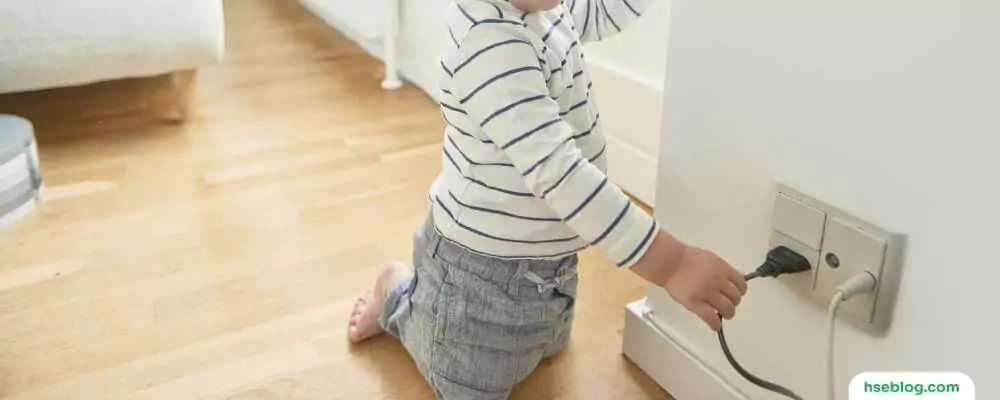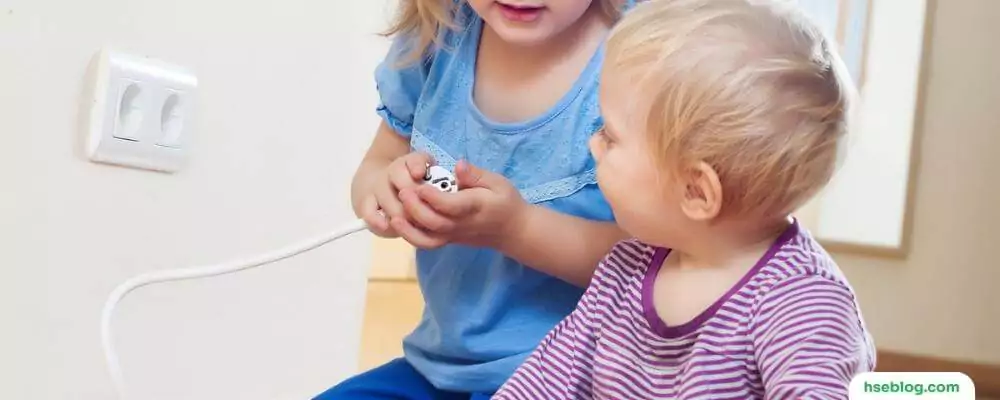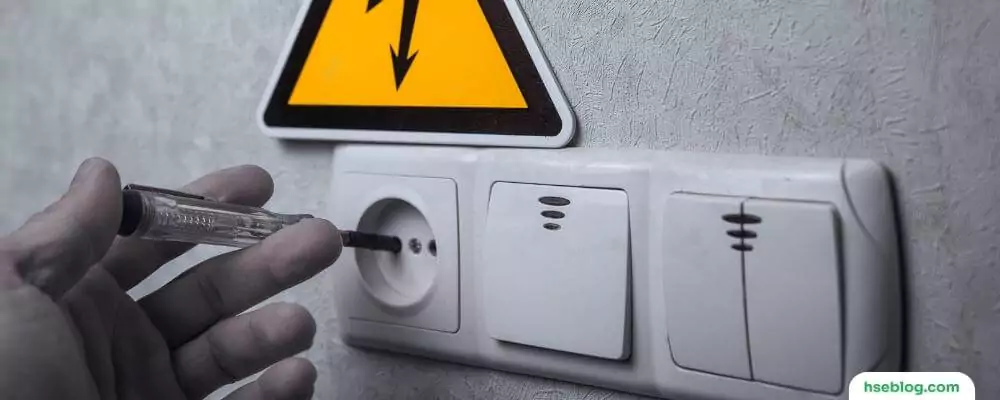Electricity makes our lives easier, powering everything from lights to fun electronic toys. But as parents, it’s essential to understand that electricity can pose a risk to children if not handled with care. Teaching your child about electrical safety is crucial for their well-being.
This guide will provide essentials like understanding electricity, age-appropriate safety rules, and practical ways to create safe habits within your home. By being proactive, you can help prevent accidents and keep your little ones out of harm’s way regarding electricity.

Understanding the Basics
Understanding the basics of electricity safety is crucial for children, as it helps them navigate their environment safely. Here’s how you can explain these concepts to kids in an age-appropriate manner:
1. Explain Electricity
- Tiny Power Helpers: Tell your child electricity is made up of super-small things called “electrons” that we can’t see. These electrons have energy, and they love to move!
- Like a Busy Highway: Explain that wires are particular roads for the electrons to travel. Inside the wires, the electrons zip along, carrying the energy to light our homes and power our toys.
- Why Safety is Important: We must be careful because electricity is so powerful. Think of it like a super-fast bike – it’s fun, but we need to wear a helmet and know the rules to be safe.
2. Off-Limits Areas
- Special Control Rooms: Some rooms have boxes with lots of switches and wires – that’s where the electricity for the whole house is controlled. These rooms are for grown-ups only.
- Tool Time is for Adults: Rooms where adults keep power tools are off-limits for kids. Those tools use extra strong electricity, so they must be used only by adults who know how to be safe.
3. Never Mix Electricity and Water
- Electricity Loves Water (But That’s Bad!): Electricity likes to move around, and water helps it move even faster. That’s why water and electricity together can be super dangerous.
- Bathroom Rules: No playing with anything that plugs in near the bathtub, sink, or even wet floors. Hairdryers and other electrical things stay far away from water.
- Outside Fun = Dry Hands: If it’s raining or you’ve been in the pool, your hands must be completely dry before touching light switches, plugs, or anything electrical.
Tips for Explaining:
- Use Pictures: Simple drawings of an electron, a wire, and a light bulb can help your child visualize how the flow of electricity works.
- Be Patient: The concept of electricity may take some repetition to sink in.
- Positive Attitude: Explain safety rules in a calm way that emphasizes being safe rather than scaring your child.

Electrical Safety Rules to Teach Your Kids
Teaching your kids electrical safety rules is essential for preventing accidents and ensuring their well-being. Here are some fundamental rules to impart:
1. Outlets: Hands-Off Zone
- Outlets are not toys: Explain that outlets power important things like lights and appliances, but they are not for playing. Make this a firm and repeated rule.
- Outlet covers for extra safety: Use plastic outlet covers or opt for tamper-resistant outlets for toddlers and young children. This adds another layer of protection.
- Only plugs belong: Teach kids that the only things that should ever go into an outlet are plugs from adults’ appliances. Fingers, toys, and other objects are dangerous in outlets.
2. Handling Appliances the Right Way
- Pull the plug, not the cord: Show your children how to unplug things by firmly holding the hard plastic part (the plug) and pulling straight out. Explain that yanking cords can damage them and even cause shocks.
- No tangled cords: Teach them to keep cords tidy. Show how to loosely loop cords and never wrap them tightly around appliances. Cords shouldn’t be left under rugs, furniture, or where they can be tripped over.
- Unplug when not in use: Small appliances like toasters or hairdryers should be unplugged when you finish using them. This is a good habit for children (and adults) to learn.
3. Power Lines are Always Off-Limits
- Trees and power lines don’t mix: Kids love to climb, but trees near power lines are dangerous. The electricity can jump to the tree’s branches and hurt them badly.
- Kites fly far away: Big open fields are the best places for kites. Explain that kites can get tangled in power lines and that trying to get them down is extremely hazardous.
- Fallen wires = Big danger: Tell your child to never touch a wire on the ground. They should find an adult immediately and tell them about the wire.
4. “Danger” Means Stay Far Away
- Warning signs are serious: Teach your child what “Danger!” signs look like, especially those with a lightning bolt symbol. Explain that these signs mean something dangerous is nearby, and they should never go near them.
- Substations are not for playing: Those big fenced-in areas with electrical equipment are off-limits. If a ball or toy goes inside, tell your kids to leave it and get an adult.
Additional Important Rules
- Water and electricity don’t mix: This is a super important rule! No using hairdryers, phones, or anything electrical near sinks, bathtubs, pools, or when outside in the rain.
- Ask an adult for help: If a toy is broken, a cord looks funny, or a spark happens, kids should always get an adult – no trying to fix electrical things themselves.
- Damaged things get thrown away: Teach kids to tell you immediately if a cord is frayed or an appliance looks cracked or broken. These items are dangerous and shouldn’t be used.
Remember: Talk about these rules often! Kids need reminders, and discussing electricity safely makes it less mysterious and scary.

Tips for Fostering Electrical Safety Habits
Fostering electrical safety habits in children is crucial for their protection and development of responsible behavior. Here are some effective tips for parents and guardians to help instill these habits:
1. Lead by Example: Your Actions Speak Louder
Kids are always watching and learning from you. If you’re careful about unplugging appliances, keeping cords tidy, and being cautious around water, they’ll notice and be more likely to follow the same habits.
2. Make it a Game: Learning Through Fun
- Outlet Patrol: Give your child a special “job” to check that all outlets have covers. They can be your Outlet Safety Officer!
- Cord Detective: Have them help you find cords that need untangled or tucked away for safety.
- Reward System: Small stickers or a point system for remembering rules like not touching switches or leaving appliances unplugged can be motivating.
3. Supervise Appliance Use: Safety First
- Cooking is Teamwork: Make a joint activity using the toaster, blender, or microwave. This lets you teach them safe use directly.
- Bathroom Helpers: Even older kids should have an adult nearby when using hairdryers or straighteners, especially near water.
4. Inspect Toys & Equipment: Prevention is Key
- Regular Check-ups: Make it a habit to inspect the cords of kids’ toys, nightlights, game systems, etc. Look for any frays, tears, or exposed wires.
- Broken = Trash: If you find damage, don’t try to repair it. Throw the item away immediately to prevent accidental shocks.
5. Know First Aid: Be Prepared
- Learning the Basics: Take a first aid course or research reliable resources to learn how to handle an electrical shock.
- Know Your Fuse Box: Find where your home’s electrical panel (fuse box or circuit breaker) is and how to shut off power quickly if necessary.
Additional Notes:
- Age Matters: Tailor supervision and games to your child’s age and understanding.
- Talk It Out: Explain why these habits are important, not just what the rules are.
Additional Safety Measures
- Install Outlet Covers: Child-safe covers are an easy way to prevent toddlers and young kids from accessing outlets.
- Consider GFCI Outlets: Ground Fault Circuit Interrupter outlets can cut power if they detect an electrical imbalance, offering enhanced protection in places like bathrooms and kitchens.
- Emergency Resources: Keep the number of the local electricity provider and poison control center readily available.
Remember, accidents can happen, but prevention is key. By being proactive and emphasizing safety rules, you can help keep your children protected from electrical hazards.
Resources for More Information:
- The Electrical Safety Foundation International (ESFI): https://www.esfi.org/
- Safe Kids Worldwide: https://www.safekids.org/
Conclusion
Remember, electrical safety isn’t a one-time lesson. Revisit these rules often, making them a consistent part of your family’s safety conversations. By emphasizing the importance of respecting electricity and fostering safe habits, you’ll empower your children with the knowledge to protect them for a lifetime. Resources like the Electrical Safety Foundation International (ESFI) and Safe Kids Worldwide provide excellent information and support if you ever need a refresher.

